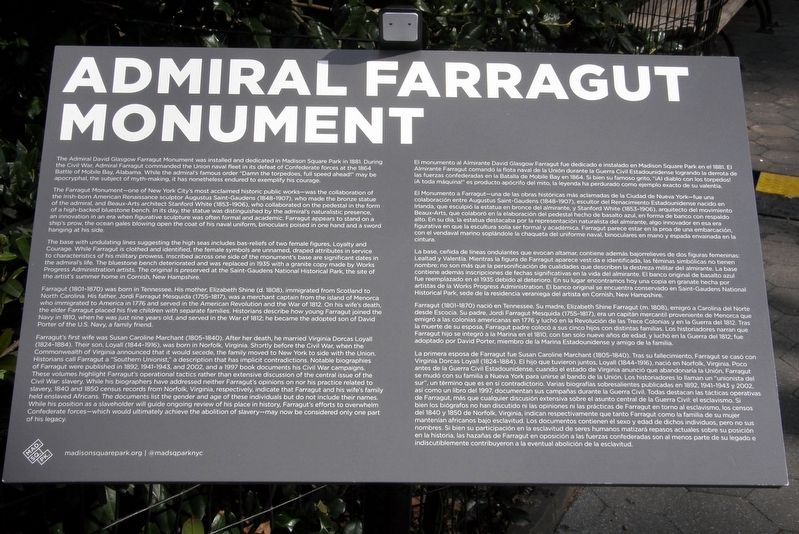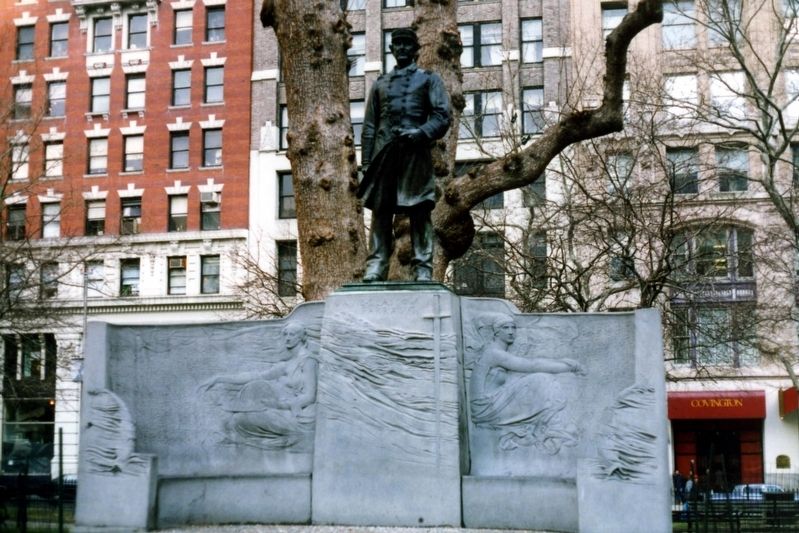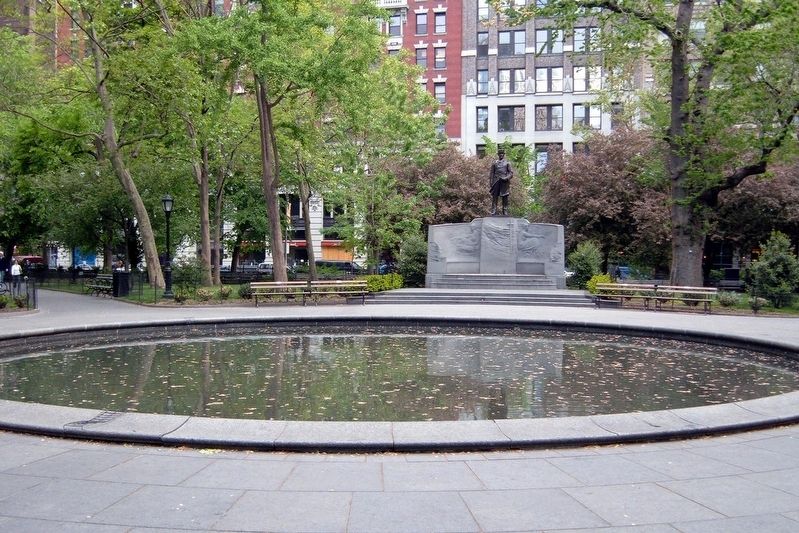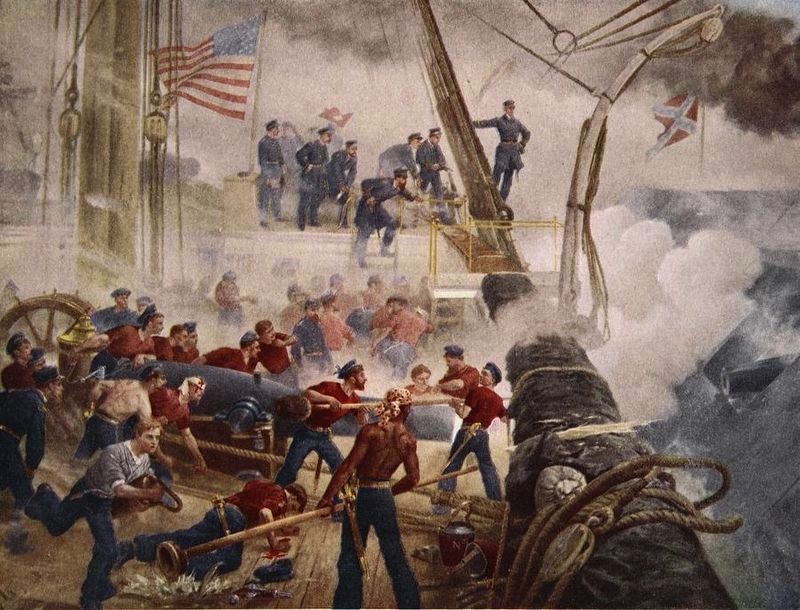NoMad in Manhattan in New York County, New York — The American Northeast (Mid-Atlantic)
Admiral Farragut Monument
The Admiral David Glasgow Farragut Monument was installed and dedicated in Madison Square Park in 1881. During the Civil War, Admiral Farragut commanded the Union naval fleet in its defeat of Confederate forces at the 1864 Battle of Mobile Bay, Alabama. While the admiralís famous order “Damn the torpedoes, full speed ahead!” may have been apocryphal, the subject of myth-making, it has nonetheless endured to exemplify his courage.
The Farragut Monument—one of New York Cityís most acclaimed historic public works—was the collaboration of the Irish-born American Renaissance sculptor Augustus Saint-Gaudens (1848-1907), who made the bronze statue of the admiral, and Beaux-Arts architect Stanford White (1853-1906), who collaborated on the pedestal in the form of a high-backed bluestone bench In its day the statue was distinguished by the admiralís naturalistic presence, an innovation in an era when figurative sculpture was often formal and academic. Farragut appears to stand on a shipís prow, the ocean gales blowing open the coat of his naval uniform, binoculars poised in one hand and a sword hanging at his side.
The base with undulating lines suggesting the high seas includes bas-reliefs of two female figures, Loyalty and Courage. While Farragut is clothed and identified, the female symbols are unnamed, draped attributes in service to characteristics of his military prowess. Inscribed across one side of the monumentís base are significant dates in the admiralís life. The bluestone bench deteriorated and was replaced in 1935 with a granite copy made by Public Works Administration artists. The original is preserved at the Saint-Gaudens National Historic park, the site of the artistís summer home in Cornish, New Hampshire.
Farragut (1801-1870) was born in Tennessee. His mother, Elizabeth Shine (d. 1808), immigrated from Scotland to North Carolina. His father, John Farragut Mesquide (1755-1817), was a merchant captain from the island of Menorca who immigrated to America in 1776 and served in the American Revolution and the War of 1812. On his wifeís death, the elder Farragut placed his five children with separate families. Historians describe how young Farragut joined the Navy in 1810, when he was just nine years old, and served in the War of 1812; be became the adopted son of David Porter of the U.S. Navy, a family friend.
Farragutís first wife was Susan Caroline Marchant (1805-1840). After her death, he married Virginia Dorcas Loyall (1824-1884). Their son, Loyall (1844-1916), was born in Norfolk, Virginia. Shortly before the Civil War, when the Commonwealth of Virginia announced that it would secede, the family moved to New York to side with the Union. Historians call Farragut a “Southern Unionist,” a description that has implicit contradictions. Notable biographies of Farragut were published in 1892, 1941-1943, and s00s, and a 1997 book documents his Civil War campaigns. These volumes highlight Farragutís operational tactics rather than extensive discussion of the central issue of the Civil War; slavery. While his biographers have addressed neither Farragutís opinions on nor his practice related to slavery, 1840 and 1850 census records from Norfolk, Virginia, respectively, indicate that Farragut and his wifeís family held enslaved Africans. The documents list the gender and age of these individuals but do not includes their names. While his position as a slaveholder will guide ongoing review of his place in history, Farragutís efforts to overwhelm Confederate forces—which would ultimately achieve the abolition of slavery—many now be considered only one part of his legacy.
madisonquarepark.org/@madsparknyc
Topics. This historical marker and monument is listed in these topic lists: Arts, Letters, Music • War, US Civil. A significant historical year for this entry is 1864.
Location. 40° 44.572′ N, 73° 59.235′ W. Marker is in Manhattan, New York, in New York County. It is in NoMad. Marker can be reached from East 26th Street west of Madison Avenue, on the right when traveling east. Located in Madison Square Park. Touch for map. Marker is at or near this postal address: 11 Madison Avenue, New York NY 10010, United States of America. Touch for directions.
Other nearby markers. At least 8 other markers are within walking distance of this marker. Chester Alan Arthur (within shouting distance of this marker); David Glasgow Farragut (within shouting distance of this marker); Let It Grow! (within shouting distance of this marker); New York Life Veterans Memorial (within shouting distance of this marker); Welcome to Madison Square Park! / Caring for Your Park (within shouting distance of this marker); New York Life Building (within shouting distance of this marker); Appellate Division of the Supreme Court (about 300 feet away, measured in a direct line); Metropolitan Life Veterans Memorial (about 300 feet away). Touch for a list and map of all markers in Manhattan.
Also see . . .
1. Madison Square Park. (Submitted on March 19, 2020.)
2. The Admiral Farragut Memorial -- Madison Square. "Daytonian in Manhattan" entry. (Submitted on April 7, 2020, by Larry Gertner of New York, New York.)
3. Admiral David Glasgow Farragut. Official NYC Parks description. (Submitted on April 7, 2020, by Larry Gertner of New York, New York.)
Credits. This page was last revised on January 31, 2023. It was originally submitted on March 18, 2020, by Larry Gertner of New York, New York. This page has been viewed 260 times since then and 48 times this year. Photos: 1, 2, 3, 4. submitted on March 18, 2020, by Larry Gertner of New York, New York. • Bernard Fisher was the editor who published this page.



